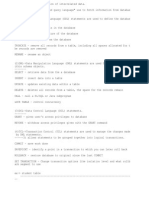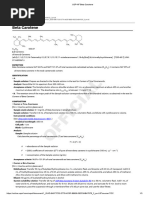SQL_3
Uploaded by
workaholicprateek.india05SQL_3
Uploaded by
workaholicprateek.india05SQL
table students
rollno name age class fee sex dob percentage city
Use of between in place of and ( when we use same column for creating a range using ‘and’ condition then we can
use ‘between’ in place of ‘and’. When we use ‘between’ both values are included in the range)
In following both query we are finding age from 16 to 20
SQL> select name, age from students
Where age>= 16 and age<= 20 ;
SQL> select name, age from students
Where age between 16 and 20 ;
SQL> select name, age, fee from students
Where fee between 1800 and 3000 ;
Use of in in place of or ( when we use same column for creating a condition using ‘or’ then we can use ‘in’ in place of
‘or’.
In following both query we are finding age from 16 to 20
SQL> select name, age from students
Where age= 16 or age= 20 ;
SQL> select name, age from students
Where age in(16, 20) ;
SQL> select name, class, fee from students
Where name=’Sachin’ or name=’Sanjay’ ;
SQL> select name, class, fee from students
Where name in(’Sachin’,’Sanjay’) ;
Use of ‘like’ for character type columns. We use ‘like’ to fine some specific value in character column. We use ‘%’ with
like, ‘%’ indicates any character any number of times. And ‘_’ (underscore) indicates one character.
SQL> select name, fee from students
Where name='Sachin' ;
[name starting with ‘s’]
SQL> select name, fee from students
Where name like 'S%' ;
[name ending with ‘a’]
SQL> select name, fee from students
Where name like '%a' ;
[name ending with ‘i’]
SQL> select name, fee from students
Where name like ’%i' ;
[third char in name is ‘a’, two underscore without space and ‘a’]
SQL> select name, fee from students
Where name like ’_ _a%' ;
[Second char in name is ‘a’, one underscore without space ‘a’]
SQL> select name, fee from students
Where name like ’_a%' ;
[Name has only four character, four underscore without space ]
SQL> select name, fee from students
Where name like ’_ _ _ _' ;
[Name has only three character, three underscore without space ]
SQL> select name, fee from students
Where name like ’_ _ _' ;
[Name has ‘a’ in any place ]
SQL> select name, fee from students
Where name like ’%a%' ;
[we can display any calculation from integer column , 10% of fee column]
SQL> select name, fee, fee*0.1 from students;
[we can display any calculation from integer column, 10% of fee column of class ‘XII-A’ ]
SQL> select name, fee, fee*0.1 from students
Where class=’XII-A’ ;
[we can change any column name only for display purpose, using ‘ new column name’ method ]
SQL> select name ‘students name’ , fee, fee*0.1 ‘ discount’ from students;
Order By clause [used to display data in any order ascending or descending order] (by default ascending order for
descending order we have to write ‘desc’ with column name)
SQL> select name, age from students
Order by age ;
SQL> select name, age from students
Order by age desc ;
SQL> select name, age, fee from students
Order by fee ;
SQL> select name, age, fee from students
Order by fee desc ;
SQL> select name, age, class from students
Order by class ;
SQL> select name, age, class from students
Order by class desc;
[when values are same in any column then we can use any other column for further sorting ]
[ class and age is in ascending]
SQL> select name, age, class from students
Order by class, age ;
[ class is in ascending order and age is in descending order]
SQL> select name, age, class from students
Order by class, age desc;
[ class is in descending order and age is in ascending order]
SQL> select name, age, class from students
Order by class desc , age ;
[ class and age is in descending]
SQL> select name, age, class from students
Order by class desc , age desc;
[ class and age is in ascending]
SQL> select name, age, class from students
Where fee > 2700
Order by class, age ;
[ class is in ascending order and age is in descending order]
SQL> select name, age, class from students
Where fee > 2700
Order by class, age desc;
[ class is in descending order and age is in ascending order]
SQL> select name, age, class from students
Where fee > 2700
Order by class desc , age ;
[ class and age is in descending]
SQL> select name, age, class from students
Where fee > 2700
Order by class desc , age desc;
You might also like
- Computer Science Class 12 CBSE - Structure Query LanguageNo ratings yetComputer Science Class 12 CBSE - Structure Query Language41 pages
- FALLSEM2021-22 CBS1007 ELA VL2021220104396 Reference Material I 06-Aug-2021 LAB1 SQLNo ratings yetFALLSEM2021-22 CBS1007 ELA VL2021220104396 Reference Material I 06-Aug-2021 LAB1 SQL59 pages
- Let Us Consider The Schema of Student Table (Stdno Number (5), Name Varchar2 (20), Marks Number (3) )No ratings yetLet Us Consider The Schema of Student Table (Stdno Number (5), Name Varchar2 (20), Marks Number (3) )9 pages
- RDBMS: Manages Data in The Form of Tables. Related Tables in RDBMS Have Relationships Through Common ValuesNo ratings yetRDBMS: Manages Data in The Form of Tables. Related Tables in RDBMS Have Relationships Through Common Values45 pages
- SQL Practical Guide - 1: Mohamed Ghasia ICT 114 Dec 2012/13No ratings yetSQL Practical Guide - 1: Mohamed Ghasia ICT 114 Dec 2012/1342 pages
- Object 1: Write A Query Using DDL Commands.: Create CommandNo ratings yetObject 1: Write A Query Using DDL Commands.: Create Command16 pages
- DDL DML DRL TCL DCL Create Table Syntax: Create Table Student (No Number (2), Name Varchar (10), Marks Number (3) )No ratings yetDDL DML DRL TCL DCL Create Table Syntax: Create Table Student (No Number (2), Name Varchar (10), Marks Number (3) )206 pages
- Forged Cheques, Mistake of Fact and Tracing:: B.M.P. Global Distribution Inc. v. Bank of Nova ScotiaNo ratings yetForged Cheques, Mistake of Fact and Tracing:: B.M.P. Global Distribution Inc. v. Bank of Nova Scotia13 pages
- 2nd MNLU NCMC PRELIMINARY ROUND - I (GI)No ratings yet2nd MNLU NCMC PRELIMINARY ROUND - I (GI)5 pages
- 005. (Hindi Medium) Bpsc Mains Essay PaperNo ratings yet005. (Hindi Medium) Bpsc Mains Essay Paper8 pages
- AP x - Social Studies Final Chapter Wise Revision for Teachers 23-24.PmdNo ratings yetAP x - Social Studies Final Chapter Wise Revision for Teachers 23-24.Pmd16 pages
- International Journal of Heat and Mass Transfer: Jeongmin Lee, Lucas E. O'Neill, Issam MudawarNo ratings yetInternational Journal of Heat and Mass Transfer: Jeongmin Lee, Lucas E. O'Neill, Issam Mudawar19 pages
- Irrevocable General Power of Attorney With Sale Power: Page No. 1100% (1)Irrevocable General Power of Attorney With Sale Power: Page No. 14 pages
- WS - Discussion of Asphalt Concrete SpecificationNo ratings yetWS - Discussion of Asphalt Concrete Specification16 pages
- The Kano Model: How To Delight Your CustomersNo ratings yetThe Kano Model: How To Delight Your Customers16 pages
- Test Bank International Finance Ueh UniversityNo ratings yetTest Bank International Finance Ueh University78 pages
- 106749-Texto Del Artículo-433370-1-10-20240812No ratings yet106749-Texto Del Artículo-433370-1-10-202408127 pages
- TOPIC 4 (Economic and Industry Analysis)No ratings yetTOPIC 4 (Economic and Industry Analysis)28 pages

























































































